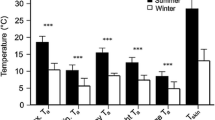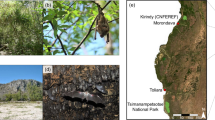Abstract
Tropical microchiropteran bats need to seek out environments of thermoneutrality which in the tropics, of course, may mean selecting ‘cooler’ places for the diurnal roosts. Thus the roosting sites of all the species studied,Rhinopoma hardwickei, Taphozous melanopogon, Hipposideros speoris, Hipposideros bicolor andMegaderma lyra inhabiting caves, caverns, interiors of temples and a cellar were cooler by several degrees and showed a relatively constant temperature than outside in the open. Such a lower and relatively constant temperature found in the roosts apparently aid in lowering the metabolic rate and cost and may be vital in these tropical species that do not hibernate and some of which may be (such asHipposideros speoris) continuous breeders. This paper presents the temperature and light intensity profiles of bat roosts over 24 h periods for the course of an entire year. It is found that physical protection from predators, relative constancy of temperatures, lower levels of illumination and high humidity seem to determine the choice for roosts in these species of bats.
Similar content being viewed by others
References
Brosset A 1962 The bats of central and western India part I;J. Bombay Nat. Hist. Soc. 59 1–57
Davis W H 1970 Hibernation: ecology and physiological ecology; In Biology of Bats (ed.) W A Wimsatt (New York: Academic Press)1 265–300
Davis R B, Herreid C F and Short H L 1962 Mexican free-tailed bats in Texas;Ecol. Monogr. 32 311–346
Fenton M B 1970 Population studies ofMyotis lucifugus (Chiroptera: Vespertilionidae) in Ontario;Life Sci. Contr. R. Ont. Mus. 77 1–34
Goodwin R E 1970 The ecology of Jamaican bats;J. Mammal. 51 571–579
Greenhall A M and Paradiso J L 1968 Bats and bat banding;Bur. Sport Fish. Wildl. (US) Res. Rep. 72 1–46
Herreid C F 1963 Survival of migratory bat at different temperatures;J. Mammal. 44 431–433
Humphrey S R, Richter A R and Cope J B 1977 Summer habitat and ecology of the endangered Indiana batMyotis sodalis;J. Mammal. 58 334–346
Klopfer P H and Hailman J P 1965 Habitat selection in birds. InAdvances in the study of behaviour (eds) D S Lehrman, R A Hinde and E Shaw (New York: Academic Press)1 279–303
Kunz T H 1973 Population studies of the cave bat (Myotis velifer): reproduction, growth and development;Mus. Nat. Hist. Univ. Kans. 15 1–43
Kunz T H 1974 Feeding ecology of a temperate insectivorous bat (Myotis velifer);Ecology 55 693–711
Licht P and Leitner P 1967 Behavioural responses to high temperatures in three species of Californian bats;J. Mammal. 48 52–61
McNab B K 1982 Evolutionary alternatives in the physiological ecology of bats. inEcology of bats (ed.) T H Kunz (New York, London: Plenum Press) pp 151–200
Meher-Homji V M 1978 Ecological climatography and vegetation cartography;Proc. School Plant Ecol. 26–42
O’Farrell M J and Bradley W G 1970 Activity patterns of bats over a desert spring;J. Mammal. 51 18–26
Schoener T W 1971 Theory of feeding strategies;Annu. Rev. Ecol. Syst. 2 369–404
Selvanayagam P F L and Marimuthu G 1984 Spatial organization of roosting in the insectivorous tropical batHipposideros speoris;Behav. Processes 9 113–121
Stones R C and Wiebers J E 1965 A review of temperature regulation in bats (Chiroptera);Am. Midl. Nat. 74 155–167
Studier E H and O’Farrell M J 1972 Biology ofMyotis thysanodes andM. lucifugus (Chiroptera: Vespertilionidae) I. Thermo-regulation;Comp. Biochem. Physiol. A41 567–595
Tuttle M D 1975 Population ecology of the gray bat (Myotis grisescens): Factors influencing early growth and development;Occas. Pap. Mus. Nat. Hist. Univ. Kans. 36 1–24
Twente J W 1955 Some aspects of habitat selection and other behaviour of cavern-dwelling bats;Ecology 36 706–732
Vaughan T A and O’Shea T J 1976 Roosting ecology of the pallid batAntrozous pallidus;J. Mammal. 57 19–42
Vaughan T A and Vaughan R P 1986 Seasonality and the behaviour of the African yellow-winged bat;J. Mammal. 67 91–102
Wilson D E 1971 Ecology ofMyotis nigricans (Mammalia: Chiroptera) on Barro Colorado Island, Panama Canal Zone;J. Zool. Proc. Zool. Soc. London 163 1–13
Wilson D E and Laval R K 1974Myotis nigricans;Mamm. Species 39 1–3
Author information
Authors and Affiliations
Rights and permissions
About this article
Cite this article
Usman, K. Role of light and temperature in the roosting ecology of tropical microchiropteran bats. Proc. Indian Acad. Sci. (Anim. Sci.) 97, 551–559 (1988). https://doi.org/10.1007/BF03179557
Received:
Issue Date:
DOI: https://doi.org/10.1007/BF03179557




